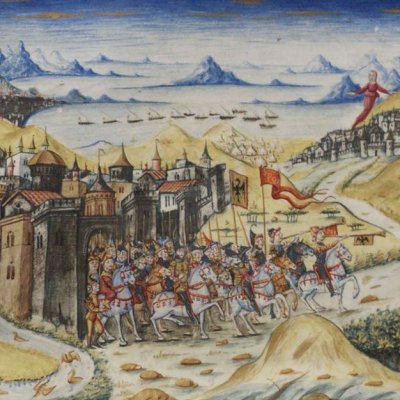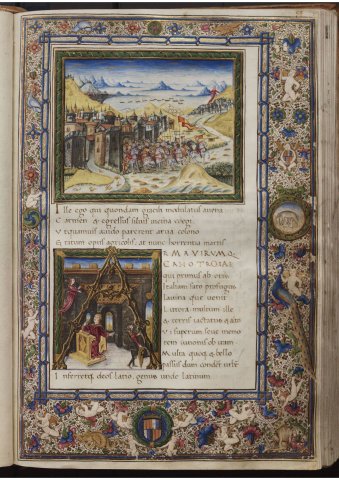Beginning and program of the Aeneid (Virgil, Aeneid, I, Escurial RBME S-II-19, f53r)
Notice précédente Notice n°7 sur 25 Notice suivante
Description
This first miniature from the Aeneid is unusual and disconcerting: it's neither the destruction of Troy, nor the storm.
Let's try several reading hypotheses.
A first, scholarly hypothesis would be to imagine a contamination of the Roman de Troie, which unlike the Eneid starts from the origins of the war. In the foreground, the troop of horsemen riding out of one city with great pomp, heading towards another city in the background on the right, guided by a goddess, would designate the Greeks, driven by Juno to the Trojan War.
In the background on the right, in the hollow of a valley near the sea, a camp is set up opposite a city: these would again be the Greeks, besieging Troy.
In the background on the left, a city is in flames, and almost destroyed. Troy again? A fleet crosses the sea horizon from left to right: this would be the fleet of Aeneas and his companions, leaving for Carthage.
This hypothesis isn't very convincing: the Greeks aren't coming from a city, they're crossing the sea to get to Troy, and above all this isn't the beginning of the Aeneid at all.
A second, trivial hypothesis would be to assume that the illuminator illustrated literally the first verses: in the foreground, arma virumque cano, I sing, is represented by the leading cavalrymen sounding their trumpets, while the weapons and the hero take on the consistency of a troop of cavalrymen in arms; this troop is coming out of Troy: Troiae qui primus ab oris is represented by Aeneas coming gloriously out of his city. Narratively, this is a contradiction, but literally it mimics the text to some extent.
Verse 2 is depicted in the background: the path taken by Aeneas and his troop leads to a city by the sea, Laviniaque venit litora, opposite which the illuminator has drawn what would be a camp of Trojan besiegers. This is not Virgil's account in Books VII to XII, but it is the myopic reading of the verse. Above the city floats a goddess dressed in red, a figure we'll see again in the next miniature: it's Juno. Verse 4, ui superum saeuae memorem Iunonis ob iram, tells us in effect that all this is taking place by the will of the gods, because of Juno's resentful anger. Juno floating above Lavinium with arms outstretched, as it were, bars access.
But what exactly is taking place? Not Aeneas' direct arrival, but his tribulations in getting there: that's verse 3 and the 3rd shot of the miniature. Multum ille et terris iactatus et alto, Aeneas has been much abused both on land and sea: on land first on the left, it's the burning of Troy; then on sea, and it's the line of ships leaving for exile.
This interpretation still poses a problem: A river here flows out of the city in the left foreground. Troy is never depicted with a river running through it. And if Aeneas emerges from Troy, it's from Troy in flames: even a moderately learned illuminator must know this.
A third hypothesis would be to differentiate three stages in the construction of the Aeneid program: at the top, the Trojans leave Troy in flames and cross the sea; in the middle right, they lay siege to Laurente, which will decide the conquest of Italy; at the bottom, Aeneas, master of Lavinium and Italy, makes a triumphal parade.
The historiated A depicts Virgil writing under the inspiration of his Muse.
2. Folio 53 recto.
Technical Data
Notice #025097


